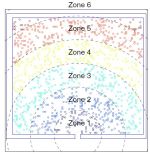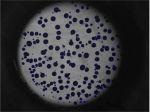News
EPJ Plus Highlight - Carbon dating uncovers forged Cubist painting
- Details
- Published on 19 February 2014

Physicists use carbon dating to confirm alleged Fernand Léger painting was definitely a fake, thus corroborating the doubts about its authenticity previously expressed by art historians
Choosing the right physical technique to analyse paintings can make all the difference when it comes to ascertaining their authenticity. Now, a painting initially attributed as belonging to a series called ‘Contraste de formes’ by French Cubist painter Fernand Léger has definitely been identified as a forgery. This is the first time it has been possible to identify a fake painting by relying on the anomalous behaviour of the concentration of the radioactive form of carbon (14C) in the atmosphere after 1955 to date the canvas. These findings were recently published in EPJ Plus by Mariaelenea Fedi of the National Institute of Nuclear Physics (INFN) in Florence, Italy, and colleagues.
EPJ Plus Highlight - Scaling up renewable energy
- Details
- Published on 19 February 2014

A new study focuses on the feasibility of scaling up renewable energy to cover the needs of a country the size of Germany
Can renewable energy adequately supply the power grid, despite its intermittent nature? This is the key question in a new study published in EPJ Plus. The study is based on an analysis of concrete data from 2012 for the German national grid, which also utilises electricity from both on and offshore wind (8%) and solar sources (4.8%). Friedrich Wagner from the Max-Planck Institute for Plasma Physics in Greifswald, Germany, outlines the key issues associated with the use of renewable energy on a large scale.
EPJ B Highlight - Probing the edge of chaos
- Details
- Published on 18 February 2014

To understand natural phenomena with a chaotic nature, the key is to find out how their variable physical characteristics behave at the very point preceding the onset of chaos
The edge of chaos—right before chaos sets in—is a unique place. It is found in many dynamical systems that cross the boundary between a well-behaved dynamics and a chaotic one. Now, physicists have shown that the distribution—or frequency of occurrence—of the variables constituting the physical characteristics of such systems at the edge of chaos has a very different shape than previously reported distributions. The results have been published in EPJ B by Miguel Angel Fuentes from the Santa Fe Institute in New Mexico, USA, and Universidad del Desarrollo, Chile, and Alberto Robledo from the National Autonomous University of Mexico, Mexico City. This could help us better understand natural phenomena with a chaotic nature.
EPJ B Highlight - Optimising custody is child’s play for physicists
- Details
- Published on 11 February 2014

Ensuring that parents in recomposed families see their children regularly is a complex network problem that models developed to study materials may help to solve
Physics can provide insights into societal trends. Problems involving interactions between people linked in real-life networks can be better understood by using physical models. As a diversion from his normal duties as a theoretical physicist, Andrés Gomberoff from the Andres Bello University, in Santiago, Chile, set out to resolve one of his real-life problems: finding a suitable weekend for both partners in his recomposed family to see all their children at the same time. He then joined forces with a mathematician and a complex systems expert. This resulted in a study published in EPJ B, showing that solving this problem essentially equates to minimising the energy in a material model.
EPJ H Highlight - Einstein’s forgotten model of the universe
- Details
- Published on 05 February 2014

New insights into Einstein’s view of the cosmos from the translation and study of one of his least known papers
A paper published in EPJ H provides the first English translation and an analysis of one of Albert Einstein’s little-known papers, “On the cosmological problem of the general theory of relativity”. Published in 1931, it features a forgotten model of the universe, while refuting Einstein’s own earlier static model of 1917. In this paper, Einstein introduces a cosmic model in which the universe undergoes an expansion followed by a contraction. This interpretation contrasts with the monotonically expanding universe of the widely known Einstein-de Sitter model of 1932.
EPJ H Highlight - Einstein’s conversion from a static to an expanding universe
- Details
- Published on 05 February 2014

Albert Einstein accepted the modern cosmological view that the universe is expanding, only long after several of his contemporaries had demonstrated it with astrophysical observations
Until 1931, physicist Albert Einstein believed that the universe was static. An urban legend attributes this change of perspective to when American astronomer Edwin Hubble showed Einstein his observations of redshift in the light emitted by far away nebulae—today known as galaxies. But the reality is more complex. The change in Einstein’s viewpoint, in fact, resulted from a tortuous thought process. Now, in an article published in EPJ H, Harry Nussbaumer from the Institute of Astronomy at ETH Zurich, Switzerland, explains how Einstein changed his mind following many encounters with some of the most influential astrophysicists of his generation.
EPJ A Highlight - MINOS: A vertex tracker coupled to a thick liquid-hydrogen target for in-beam spectroscopy of exotic nuclei
- Details
- Published on 05 February 2014

MINOS is a new apparatus dedicated to in-beam nuclear structure experiments with low-intensity exotic beams at energies above 150 MeV/nucleon.
It is intended to provide increased luminosity compared to standard solid-target experiments in hydrogen-induced studies, while simultaneously improving experimental resolution. This article exposes the concept of the device developed at the CEA in France and reviews in detail the associated recent technical advances. MINOS is composed of a thick finger-shaped liquid hydrogen target, from 50 to 200 mm thick, combined with a compact time projection chamber serving as a vertex tracker, the first of its kind in low-energy nuclear physics. This innovative setup offers access to the first spectroscopy of a new range of very exotic nuclei beyond our current reach. An exciting program on the search for new 21+ states in neutron-rich even-even nuclei, spectroscopy of unbound oxygen nuclei and di-neutron correlations in borromean nuclei will be performed with MINOS at the RIKEN Radioactive Isotope Beam Factory in Japan over the next few years. MINOS is funded by the European Research Council.
EPJ B Highlight - Bottom-up insight into crowd dynamics
- Details
- Published on 04 February 2014

A new study proposes a method for quantitatively analysing the relative value of models for crowd dynamics prediction, following individual movement
Stampedes unfortunately occur on too regular a basis. Previously, physicists developed numerous models of crowd evacuation dynamics. Their analyses focused on disasters such as the yearly Muslim Hajj or of the Love Parade disaster in Germany in 2010. Unfortunately, the casualties at these events may have been linked to the limitations of the crowd dynamics models used at the time. Now, a new study outlines a procedure for quantitatively comparing different crowd models, which also helps to compare these models with real-world data. In a paper published in EPJ B, Vaisagh Viswanathan, a PhD student from Nanyang Technological University in Singapore, and colleagues have demonstrated that these crowd evacuation dynamics models are a viable decision-making tool in safety preparation and planning concerning real-world human crowds.
EPJ Quantum Technology – A new Open-Access Journal is launched
- Details
- Published on 31 January 2014

The publishers are pleased to announce the launch of a new open-access journal in the EPJ series – EPJ Quantum Technology. The journal has just gone live, with three research papers already available.
Driven by advances in technology and experimental capability, the last decade has seen the emergence of quantum technology: a new praxis for controlling the quantum world. It is now possible to engineer complex, multi-component systems that merge the once distinct fields of quantum optics and condensed matter physics.
EPJ E Highlight - Towards tailor-made adhesives
- Details
- Published on 24 January 2014

The inner structure of soft adhesive materials during the debonding process is, for the first time, under scrutiny in the hope of producing new, improved adhesives in the future
Tape, self-adhesive labels, Post-it notes and masking tape all contain soft adhesives. This makes them easy to remove—a process referred to as debonding. French scientists have studied how soft adhesives work in the hope of facilitating the design of more efficient adhesives. Francois Tanguy, a researcher at ESPCI ParisTech, the School of Industrial Physics and Chemistry, in Paris, France, and colleagues have, for the first time, performed a precise analysis of the material deformation and structure during the course of debonding for several model adhesives. Their findings are published in EPJ E. By better understanding the connection between the energy dissipated by the polymeric material with adhesive qualities and its response to traction, they hope to improve models of adhesive performance.





